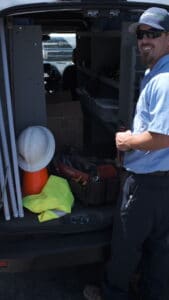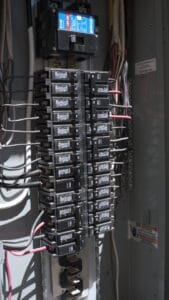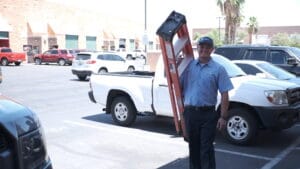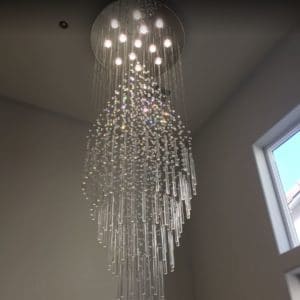Where to find a Callidus Electric Electrician

An electrical expert is a tradesperson focusing on electrical circuitry of structures, transmission lines, stationary machines, and associated devices. Electrical experts might be used in the setup of brand-new electrical elements or the upkeep and repair of existing electrical facilities. Electrical contractors may also concentrate on electrical wiring ships, airplanes, and other mobile platforms, as well as data and cable lines.
In the United States, electrical experts are divided into two main classifications: linemen, who deal with electric utility company circulation systems at higher voltages, and wiremen, who work with the lower voltages made use of inside structures. Callidus Electric Henderson Wiremen are normally trained in one of 5 main specialties: industrial, property, light industrial, commercial, and low-voltage electrical wiring, more frequently known as Voice-Data-Video, or VDV
Electrical contractors are trained to one of 3 levels: Apprentice, Journeyman, and Master Electrician. In the United States and Canada, apprentices work and get a decreased settlement while discovering their trade. They usually take several hundred hours of classroom guideline and are contracted to follow apprenticeship requirements for a period of in between 3 and six years, during which time they are paid as a percentage of the Journeyman’s pay (Pool Lighting repair).
Master Electrical contractors have actually performed well in the trade for a duration of time, frequently 7 to ten years, and have passed a test to demonstrate superior knowledge of the National Electrical Code, or NEC. Service electricians are tasked to respond to ask for separated repair work and upgrades. They have abilities troubleshooting circuitry issues, setting up wiring in existing structures, and making repairs.
Electrical Contractor Things To Know Before You Buy
Other specialty locations are marine electrical contractors, research study electricians and medical facility electrical contractors. “Electrical expert” is also utilized as the name of a role in stagecraft, where electrical experts are tasked mainly with hanging, focusing, and operating stage lighting. In this context, the Master Electrical contractor is the show’s chief electrical expert. Although theater electrical contractors routinely perform electrical work on phase lighting instruments and devices, they are not part of the electrical trade and have a different set of skills and credentials from the electrical contractors that deal with structure wiring.
Electrical professionals are businesses that employ electricians to design, set up, and keep electrical systems. Callidus Electric North Las Vegas Specialists are responsible for producing quotes for new jobs, employing tradespeople for the job, providing product to electrical contractors in a timely way, and communicating with designers, electrical and structure engineers, and the client to strategy and complete the finished item.
Many jurisdictions have regulatory constraints worrying electrical work for security factors due to the numerous dangers of dealing with electricity. Such requirements may be testing, registration or licensing. Licensing requirements differ between jurisdictions. Fans repair. An electrical expert’s license entitles the holder to perform all types of electrical installation work in Nevada without guidance.
Under Nevada law, electrical work that includes repaired wiring is strictly regulated and must practically constantly be performed by a licensed electrical expert or electrical contractor. A regional electrical expert can deal with a variety of work including air conditioning, light fittings and installation, security switches, smoke detector setup, evaluation and certification and screening and tagging of electrical home appliances – Electrical Contractor callidus electric.
How Electrical Panel can Save You Time, Stress, and Money.
In Western Nevada, the Department of Commerce tracks licensee’s and permits the general public to look for individually named/licensed Electricians (Electrical Contractor repair). Presently in Victoria the apprenticeship last for four years, during three of those years the apprentice attends trade school in either a block release of one week every month or one day weekly.
Upon successful conclusion of these examinations, supplying all other elements of the apprenticeship are acceptable, the apprentice is given an A Class licence on application to Energy Safe Victoria (ESV). An A Class electrical contractor might perform work unsupervised however is unable to work for profit or gain without having the additional certifications needed to end up being a Registered Electrical Contractor (REC) or being in the work of an individual holding REC status.
Most of the times a certificate of electrical safety should be sent to the relevant body after any electrical works are carried out. Safety devices utilized and used by electrical contractors in Nevada (including insulated rubber gloves and mats) needs to be checked regularly to guarantee it is still safeguarding the employee. Due to the fact that of the high risk included in this trade, this testing requires carried out routinely and regulations differ according to state.
An utility electrician/lineman does maintenance on an utility pole. Training of electrical contractors follows an apprenticeship model, taking four or 5 years to progress to fully certified journeyman level. Common apprenticeship programs includes 80-90% hands-on work under the supervision of journeymen and 10-20% classroom training. Training and licensing of electrical contractors is controlled by each province, however professional licenses stand throughout Canada under Contract on Internal Trade.
The smart Trick of Home Theaters That Nobody is Discussing
In order for individuals to become a licensed electrical contractors, they require to have 9000 hours of practical, on the task training. They likewise require to attend school for 4 terms and pass a provincial test. This training allows them to become journeyman electricians. Additionally, in British Columbia, a person can go an action beyond that and become a “FSR”, or field safety representative (Solar Panel Installation callidus electric).
Regardless of this, some Nevada provinces only give “permit pulling benefits” to present Master Electricians, that is, a journeyman who has actually been participated in the industry for three (3) years AND has actually passed the Master’s evaluation (i.e. Alberta). The different levels of field security agents are A, B and C. The only difference between each class is that they are able to do progressively greater voltage and present work.
The 2 credentials granting organisations are City and Guilds and EAL. Callidus Electric Paradise Electrical proficiency is required at Level 3 to practice as a ‘certified electrical contractor’ in the UK. Once qualified and showing the required level of proficiency an Electrician can use to sign up for a Joint Industry Board Electrotechnical Accreditation Scheme card in order to work on building websites or other controlled areas.
These extra certifications can be listed on the reverse of the JIB card. Beyond this level is additional training and qualifications such as EV battery charger installations or training and operating in expert locations such as street furniture or within market. The Electricity at Work Laws are a statutory document that covers the usage and proper upkeep of electrical devices and setups within businesses and other organisations such as charities – Landscape Lighting callidus electric.
The Ultimate Guide To Led & Induction Lights
Typical amendments are published on an ad hoc bases when minor modifications occur. Fans callidus electric. The first significant upgrade of the 18th Edition were released during February 2020 primarily covering the section covering Electric lorries charger setups although an addendum was released during December 2019 remedying some small mistakes and including some small modifications.
With the exception of the work covered by Part P Callidus Electric Enterprise of the Building Regulations, such as installing customer units, brand-new circuits or work in restrooms, there are no laws that prevent anybody from performing some basic electrical work in Las Vegas. Although lots of electrical contractors work for private professionals, lots of electricians get their start in the armed force.
There are variations in licensing requirements, however, all states acknowledge three fundamental skill classifications: level electrical contractors. Journeyman electrical contractors can work without supervision provided that they work according to a master’s Callidus Electric Las Vegas instructions. Typically, states do not use journeyman permits, and journeyman electrical experts and other apprentices can just work under licenses issued to a master electrical expert.
Before electrical experts can work unsupervised, they are generally required to serve an apprenticeship lasting from 3 to 5 years under the general guidance of a Master Electrician and typically the direct supervision of a Journeyman Electrical contractor. Education in electrical theory and electrical building regulations is required to finish the apprenticeship program.
What Does Dimmers Mean?
A Journeyman electrical expert is a classification of licensing approved to those who have actually satisfied the experience requirements for on the job training (normally 4000 to 6000 hours) and classroom hours (about 144 hours). Requirements include conclusion of two to 6 years of apprenticeship training, and passing a licensing exam. An electrical contractor’s license stands for work in the state where the license was provided.
For example, California reciprocates with Arizona, Nevada, and Utah on the condition that licenses remain in good standing and have actually been held at the other state for five years. Nevada reciprocates with Arizona, California, and Utah. Maine reciprocates with New Hampshire and Vermont at the master level, and the state reciprocates with New Hampshire, North Dakota, Idaho, Oregon, Vermont, and Wyoming at the journeyman level.
Two of the tools commonly utilized by electricians. The fish tape is utilized to pull conductors through channels, or in some cases to pull conductors through hollow walls. The conduit bender is utilized to make precise bends and offsets in electrical channel. Some of the more common tools are: Conduit Bender: Bender utilized to flex various kinds of Electrical Conduit.
Lineman’s Pliers: Heavy-duty pliers for general use in cutting, bending, crimping and pulling wire. Diagonal Pliers (likewise called side cutters or Dikes): Pliers consisting of cutting blades for use on smaller sized gauge wires, however often also used as a gripping tool for removal of nails and staples. Needle-Nose Pliers: Pliers with a long, tapered gripping nose of numerous size, with or without cutters, usually smaller sized and for finer work (consisting of really small tools utilized in electronics electrical wiring).
Getting My Attic Fans To Work
Some wire strippers consist of cable strippers amongst their numerous functions, for getting rid of the outer cable television coat. Cable television Cutters: Extremely leveraged pliers for cutting bigger cable. Armored Cable Television Cutters: Commonly referred to by the trademark ‘Roto-Split’, is a tool used to cut the metal sleeve on MC (Metal Dressed) cable.
It is offered as analog or digital screen. Common functions include: voltage, resistance, and current. Some designs offer extra functions. Unibit or Step-Bit: A metal-cutting drill bit with stepped-diameter cutting edges to enable hassle-free drilling holes in preset increments in stamped/rolled metal up to about 1.6 mm (1/16 inch) thick. Typically used to produce custom-made knock-outs in a breaker panel or junction box.
Utilized to manipulate cables and wires through cavities (LED & Induction Lights callidus electric). The fishing tool is pushed, dropped, or shot into the installed raceway, stud-bay or joist-bay of a finished wall or in a floor or ceiling. Then the wire or cable television is connected and drew back. Crimping Tools: Utilized to use terminals or splices.
Some hand tools have ratchets to guarantee correct pressure. Hydraulic units attain cold welding, even for aluminum cable television. Insulation Resistance Tester: Commonly described as a Megger, these testers use numerous hundred to several thousand volts to cable televisions and equipment to determine the insulation resistance value. Knockout Punch: For punching holes into boxes, panels, switchgear, and so on.
About Architectural Lighting
GFI/GFCI Testers: Used to check the performance of Callidus Electric Summerlin Ground-Fault Interrupting receptacles. Voltmeter: An electrical contractor’s tool used to determine electrical possible distinction in between 2 points in an electric circuit. Other general-use tools include screwdrivers, hammers, reciprocating saws, drywall saws, flashlights, chisels, tongue and groove pliers (Typically described as ‘Channellock’ pliers, a famous maker of this tool) and drills.
An electrician may experience electrical shock due to direct contact with stimulated circuit conductors or due to stray voltage triggered by faults in a system. An electrical arc exposes eyes and skin to harmful amounts of heat and light. Malfunctioning switchgear might trigger an arc flash incident with a resultant blast.
Lockout and tagout treatments are used to make sure that circuits are proven to be de-energized before work is done. Limits of technique to stimulated equipment secure against arc flash direct exposure; specially designed flash-resistant clothes provides additional security; grounding (earthing) clamps and chains are utilized on line conductors to provide a noticeable guarantee that a conductor is de-energized. LED Light Installation callidus electric.
If a system can not be de-energized, insulated tools are utilized; even high-voltage transmission lines can be repaired while stimulated, when essential. Electrical workers, that includes electrical contractors, represented 34% of total electrocutions of building and construction trades employees in the United States between 19922003. Operating conditions for electrical contractors vary by expertise. Generally an electrical contractor’s work is physically requiring such as climbing up ladders and lifting tools and materials.
Some Known Factual Statements About Home Theaters
Building electrical contractors may spend much of their days in outside or semi-outdoor loud and filthy work websites. Industrial electrical experts may be exposed to the heat, dust, and noise of a plant. Power systems electrical contractors may be contacted us to work in all sort of unfavorable weather condition to make emergency situation repairs – Attic Fans installation.
The post appeared first on Callidus Electric.
from
https://calliduselectric.com/5591-2/?utm_source=rss&utm_medium=rss&utm_campaign=5591-2
from
https://papajohnpizzas.tumblr.com/post/624106993981980672









